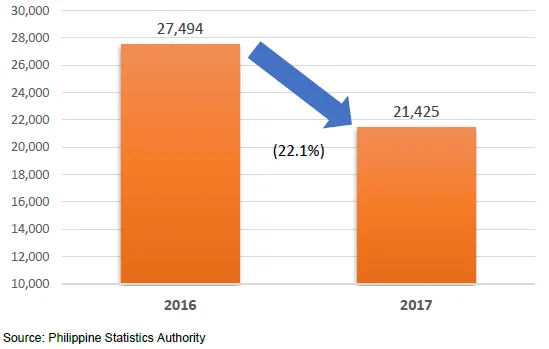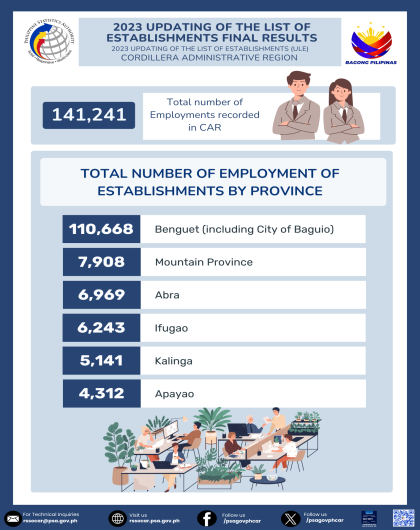Average employment at 87 workers per education establishment
- Education establishments in the region with total employment 20 and over went down to 82 establishments from 87 establishments in 2016. This was a decrease by 5.7 percent from a year ago with few establishments downgrading to less employment size.
- Employment in the education sector in larger schools reported a total of 7,141 workers in 2017. This number, a similar decrease with the number of establishments, was less by 1.8 percent than in 2016 with 7,271 workers.
- Paid education sector employees in the Cordilleras shared 99.7 percent of the total workforce of the region in 2017 with 7,117 workers. From the reported paid workers of 7,257 in 2016, it posted a decrease of 1.9 percent a year later.
Figure 1. Average Employment per Establishment and Education Establishments, CAR: 2016-2017
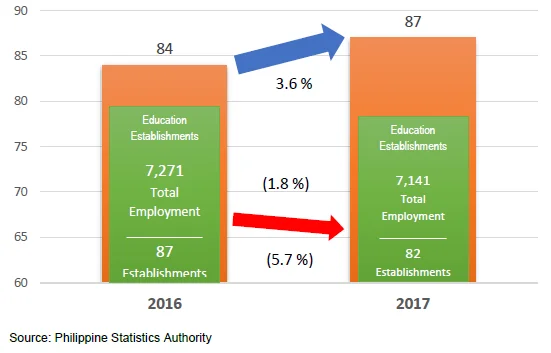
- Education establishments and its workforce contributed only 2.2 percent and 2.4 percent, respectively, to the national total in 2017. CAR ranked 12th and 11th among regions in number of establishments and total employment, respectively.
- CAR, however, was among the regions with highest average employment per establishment as the region ranked 4th with 87 workers per establishment. This was even higher than the national average of 79 workers per establishment. This was also an addition of about three more workers per establishment or 3.6 percent more than in 2016. (Figure 1).
Workers in education businesses receive ₱ 1.8 billion compensation
- PHP 3.1 billion was spent in the overall operations of Cordilleran private schools and education support establishments in 2017. The total expenses increased by 1.7 percent from PHP 3.0 billion in 2016.
- Compensation of workers shared 59.0 percent of the total expenses with PHP 1.8 billion while the rest (PHP 1.3 billion) were spent for other costs such as taxes, job contracts, goods, fees and other operation expenses.
- Following the decrease of paid employees in the education sector was the decrease of the establishments’ spending on compensation by 2.7 percent compared to 2016. These establishments’ total payment of its workers in CAR landed the region as 8th among regions in terms of compensation expenses.
Figure 2. Average Annual Compensation per Paid Worker in Education
Establishments, CAR: 2016-2017
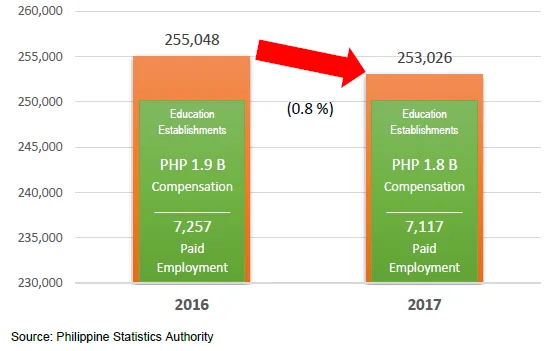
- A paid worker in private education establishment in CAR received an average of PHP 253,026 annually, or PHP 21,086 monthly. This made the region the second highest payer of education worker in 2017, following far behind NCR’s figure of PHP 400,154 per year.
- The average annual compensation of education workers in 2017 decreased by 0.8 percent from 2016 with PHP 255,048 annual average pay per worker or PHP 21,254 monthly.
Private education businesses in CAR gain 22%
- Despite the decrease of larger education establishments with total employment of 20 or more workers, these improved their income in 2017 generating PHP 3.7 billion. This was an increase of 4.6 percent from previous year, or an additional aggregated annual income of PHP 161,567 of the private education sector.
- CAR private education sector reported a return of 22.0 percent more than their operational expenses in 2017, recording an income per expense of 1.22. This was a boost of 3.4 percent from a year ago with 1.18 income per expense in 2016 (Figure 3).
Figure 3. Income Per Expense of Education Establishments, CAR: 2016-2017
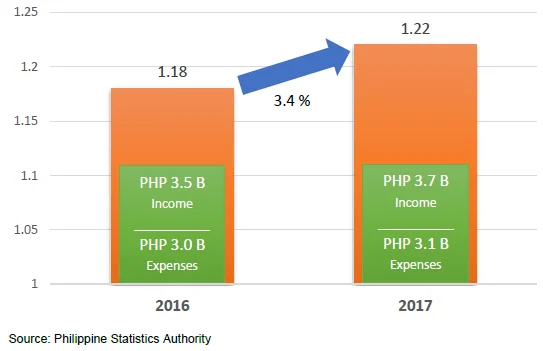
- The figure of income per expense in CAR was better than that of the national data of 1.21 income per expense. It placed 4th among regions in terms of revenue over total expenses of education businesses.
Labor productivity of Cordilleran education workers ranked 2nd among regions
- CAR businesses in private education recorded an aggregated value added of PHP 2.9 billion in 2017. This increased by 7.0 percent from PHP 2.7 billion in 2016, or an additional PHP 187,741.
- Cordillera’s value added data only shared 2.3 percent to the national total of PHP 126.2 billion, which placed the region in the 8th position among regions.
- However, the value added per total employment of CAR was recorded at PHP 403,003 in 2017. This was an increase of PHP 33,026, or an additional 8.9 percent from 2016 (Figure 4).
- The above labor productivity data lands CAR to 2nd place among regions, behind NCR with value added per worker of PHP 682,439. The national labor productivity of education businesses was at PHP 429,902.
Figure 4. Value Added per Total Employment of Education Establishments,
CAR: 2016-2017
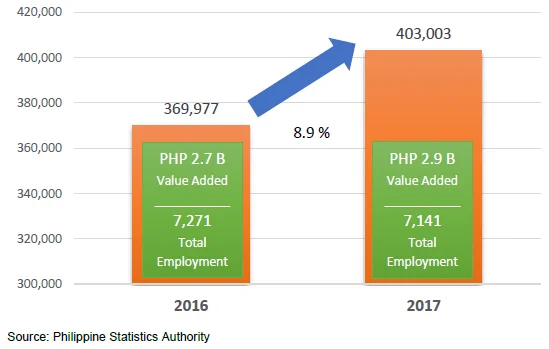
E-Commerce sales of CAR establishments reduced to nearly half of previous year
- Additions to tangible fixed assets went up to PHP 117.9 million, PHP 88.1 million more from a year ago. This was an increase of 33.9 percent, although contributing only 0.8 percent to the national total of education establishments.
- From a negative inventory in 2016, schools and other education establishments in the region recorded an inventory of PHP 6.6 million in 2017. An added amount of PHP 15.8 million helped the recovery of inventory data of the region.
